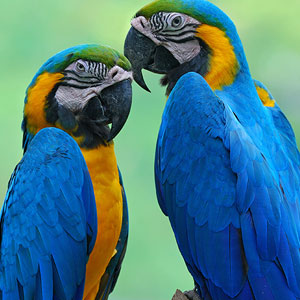
Clipping Your Bird's Wings
Many people think of wing trimming as a negative thing because it deprives a bird from natural instinct. However, others think of wing trimming as a crucial safety measure for companion birds. It can be difficult to make the decision, but keep in mind that a proper wing trim should never hurt your bird. Whether or not you trim your bird's feathers is really up to you. However, there are some factors that weigh into the decision.
Most owners that don't handle their birds, such as finches and canaries, choose to leave their birds flighted because there isn't a big chance that their birds will fly away. On the other hand, if you have a parrot and you take him out of his cage for interaction and play, you probably want to trim his wings.
There are some benefits to keeping your bird flighted. It helps birds receive necessary exercise, and it offers them the ability to do what comes naturally to them. If you feel that your bird will benefit from flying, make sure you take the necessary precautions. These precautions include being aware of open windows and doors and removing potential dangers in your home. Always closely supervise flighted birds. Do not take your bird outside if his wings aren't trimmed, unless you have a harness.
Do not try to trim your bird's wing feathers before having a trained professional show you the procedure. If you don't feel confident doing it yourself, hire a trained professional. Many bird owners choose to have a professional do the trimming for safety purposes but also so that their bird doesn't look at them as a bad guy. If you feel confident and know the proper technique, it is crucial that you have someone helping you restrain your bird in a proper manner.
Trimming steps
One thing to be aware of while wing trimming is the presence of blood feathers. These are feathers that are newly forming, and they will bleed if you cut them. The feathers will look waxy and pinkish, and you should be able to see a visible blood vessel within them. Be sure to inspect feathers before you start trimming.If you do choose to do the trimming yourself, first help your bird adjust to having his wings touched and lifted. Items you will need for the trimming include a towel, a blunt-tipped scissors, cauterizing powder, and a needle-nosed pliers. With one person restraining the bird in the towel, the other person should take the exposed wing, examine each quill, and begin trimming with the outermost primary feather. Depending on the type of bird, cut five to nine feathers off of each wing. If you cut a blood feather, use the pliers to pull the entire broken feather shaft out of the follicle and put pressure and cauterizing powder on the follicle. If the bleeding continues, take your bird to an avian veterinarian.
It is essential to take your bird to a veterinarian or a grooming professional before you try this yourself. They will give you advice, show you how the procedure is correctly done, and tell you how many feathers to trim. Lastly, if you regret trimming your bird's wings, don't worry. Your bird's feathers will grow long again when he molts—usually every six months to a year.
Discover More!
How to Clip Bird Wings (Video)Bird Feather Anatomy
My First Bird: How Do I Care For My New Bird?
Full-Spectrum Lighting for Birds
Feather Picking in Pet Birds
Return to Bird Articles


